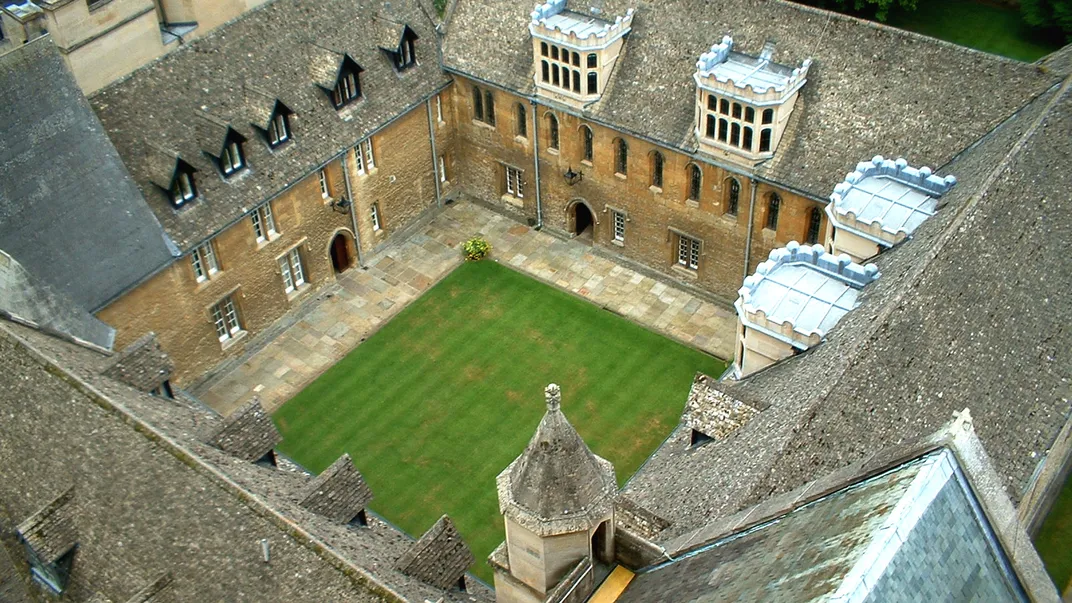/https%3A%2F%2Ftf-cmsv2-smithsonianmag-media.s3.amazonaws.com%2Ffiler_public%2F90%2Ff3%2F90f35dd0-b950-41ab-abef-9fe6188a6fc7%2Foxfordaztec.jpg)
Teaching in Oxford, England, began no later than 1096. Tenochtitlán, the capital of the Aztec Empire, was founded in 1325.
Illustration by Meilan Solly / Images: Public domain and Txllxt TxllxT via Wikimedia Commons under CC BY-SA 4.0
As early as 1096, teaching had already started in Oxford, England, setting the stage for the establishment of the oldest university in the English-speaking world. Over the next century, the University of Oxford grew rapidly, welcoming an influx of students after 1167, when England’s Henry II banned his subjects from attending the University of Paris amid his ongoing feud with Thomas Becket, an English archbishop who’d sought refuge in France.
By 1264, Oxford had grown into a full-fledged university, complete with student housing at the school’s three original halls of residence: University, Balliol and Merton Colleges. Still, Oxford is far from the world’s oldest continuously operating institution of higher education. That title, according to UNESCO and Guinness World Records, goes to the University of al-Qarawiyyin in Fez, Morocco, which was founded as a mosque in 859. Italy’s University of Bologna, established in 1088, holds the record for the oldest institution of its kind in the Western world.
Despite its nearly 1,000-year history, Oxford in many way feels like a product of our time. You can still enroll at the English university. You can still attend Merton College.
The Aztec civilization of central Mexico, on the other hand, feels anchored in the more distant past. Archaeologists dig up Aztec ruins, and museums stage exhibitions about the Mexica, as the Mesoamerican people are also known. But the dawn of the Aztec civilization, marked by the founding of the city of Tenochtitlán at Lake Texcoco—now Mexico City—didn’t arrive until 1325, 229 years after teaching began at Oxford. A 1428 alliance between Tenochtitlán and its neighboring states of Texcoco and Tlacopan cemented the Mexica’s dominance, giving rise to the Aztec Empire.
Spanish forces and their Indigenous allies captured Tenochtitlán in 1521, bringing the Aztec Empire’s reign to a close after less than a century. The White House, whose cornerstone was laid in 1792, has been standing longer than the Aztecs presided over their capital.
This comparison isn’t intended to pit civilizations against each other. But it offers an interesting way of thinking about just how skewed our understanding of history really is. Most people have timelines in their heads that are distorted and compressed, and they don’t always match up with reality.
“Humans are good at a lot of things, but putting time in perspective is not one of them,” wrote author Tim Urban in a 2013 post on his “Wait but Why” blog. “The spans of time in human history, and even more so in natural history, are so vast compared to the span of our life and recent history that it’s almost impossible to get a handle on it.”
Visual lifespans: pic.twitter.com/Y48FrhB4vm
— Tim Urban (@waitbutwhy) August 10, 2020
Consider, for instance, the fact that Cleopatra ruled over ancient Egypt at the tail end of the civilization’s 3,000-year existence—in other words, “13 centuries after King Tut, 20 centuries after the golden age of Egyptian literature [and] 26 centuries after the Great Pyramid,” as Edward Dolnick noted in The Writing of the Gods: The Race to Decode the Rosetta Stone. The year 2024 is closer in time to Cleopatra than the Egyptian queen’s life was to the construction of the pyramids.
In a 2016 blog post, Urban outlined another way of thinking about the past: “horizontally, like cutting out a complete segment of the vine tangle [of history] and examining it all together.” As he pointed out, some prominent people who are associated with disparate eras lived around the same time. Anne Frank, the most famous victim of the Holocaust, was born in 1929, the same year as civil rights icon Martin Luther King Jr. The French saint Joan of Arc was born around 1412 and is often described as a medieval heroine. Meanwhile, Jan van Eyck, one of the pioneers of Northern Renaissance art, was born prior to 1395.
On the flip side, some historical figures relegated to the ancient past in the popular imagination lived even further apart than commonly believed. Attila the Hun was born around 406, some 200 years before the Prophet Muhammad founded Islam in 610. Cleopatra’s reign began in 51 B.C.E., approximately 281 years after Alexander the Great conquered Egypt in 332 B.C.E.
To get a clearer picture of how the world really works, sometimes it helps to keep things in context.
